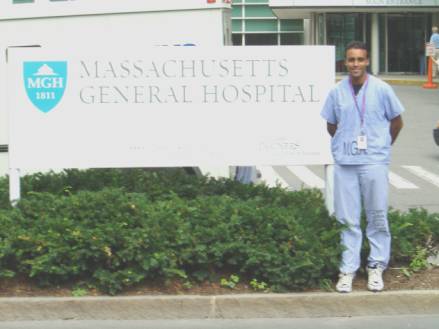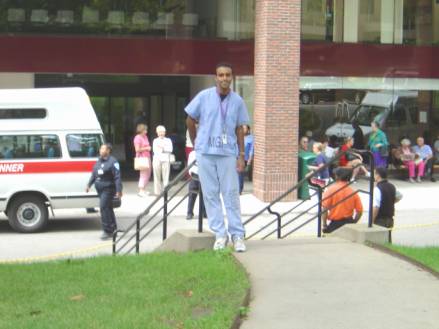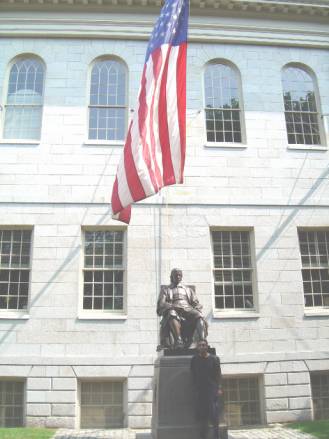
Medicine in America is taken very seriously; I heard this before left. This is reflected not just in the working patterns of the doctors, but the way the hospital and other members of the healthcare team work.
Medical students in America are also more involved with patient care and with other members of the team more so than in the UK. This meant that I had many responsibilities but learnt a lot in the process.
So no doubt electives in America are hard work with long hours, plenty of responsibility and intense training.
Massachusetts General Hospital was huge, by far the largest hospital I had ever been in. There was a busy large foyer leading off to several different wings each of which had about 20 floors. It was also clean, modern, air conditioned very much like a private UK hospital.
It was also well organised there were signs everywhere and a high staff ratio with people always at hand to direct patients to where they needed to go. I was first directed to go to the Wang building which was where all the outpatient departments were located as well as the rooms for the attending (consultant level) doctors. I then met the attending’s secretary Missy who then got my id processed, surgical scrubs and white coat issued as well as a list of the orthopaedic team’s timetable and daily schedule.
I was then given a guided tour of the parts of the hospital that I would be involved with and was told to arrive at 6.15 the next day.

Massachusetts General Hospital – founded in 1811 and the third oldest hospital in the US and the largest in New England.
My typical day started at 6.30am with a radiology meeting with both ortho teams A and B. This lasted about an hour and consisted of a review of new patients that were admitted overnight as well as a progress report on the current patients on the ward.
In the US house officers are
called interns, senior house officers are called first to fifth year residents
depending on what stage of the orthopaedic residency programme they are in,
specialist registrars are fellows and consultants are attendings.
There was a distinct hierarchy at these meetings in that junior second year residents presented patients to fellows and attendings. Then the progress of patients were reported by the senior fifth year residents. However at this meeting everyone including the students were equipped with a printout of the details of each patient that were under our care and we were expected to have followed them and like the interns and residents be fully aware of their progress. Although primarily a business rather than a teaching meeting I was able to ask questions on the patients I had previously clerked. Following a suggested plan for the future management of each patient the meeting was followed by a ward round.
A typical ward round involved the team speaking to the patient, telling them of their suggested future management as well as changing the dressings on post surgical patients. Dressings were changed each morning on every patient and this ward round differed from those in the UK in that the doctors changed patient dressings. As one of three medical students on the team I was given the responsibility of carrying the bag of dressings around my shoulder and with the intern I changed the patient dressings. This was a very valuable experience, as I had not done this previously in the UK.
Following this review of each patient I then went off to the operating rooms (OR) or outpatients. These took place on alternate days. In addition members of the team were present as the orthopaedic on call in the Emergency Room (ER).
The main difference between the OR sessions in the US and theatre in the UK that I noticed was the amount by which the US medical students participated more. In OR I was expected to help bring the patient into the anaesthetic room, then position the patient before surgery. This was in contrast to the observe role I was more previously used to. I was also expected to take the initiative and know what the drill was in theatre. This was a very rewarding experience and did typify the elective for me in that I was not a student that was there to observe how medicine worked in the US but I was there to be part of medicine in the US.
In addition during OR sessions I was also able to scrub up and assist in many procedures. I was also given my first opportunity in suturing which was thrust on me at the end of a plating operation on a gentleman’s fractured right femur. I was simply told once the plates were in to sew his leg up. I did manage having previously done this on plastic models with the help of a senior resident called Renn.
This was in the first week and following my inexperienced display Renn then took it upon himself to teach me and provide me with more experience in ER and further OR sessions throughout. This showed the nature of the teams attitude in that they were all very keen on teaching me. Whenever I was in the hospital everyone around me taught me keenly.
OR was well organised MGH has a mammoth 62 theatres performing every type of surgery, with referrals to other units for procedures infrequent.
Another aspect of OR sessions worth mentioning was the long gap between cases. This was another point that I found was different to the UK theatres, however from my point of view it meant plenty of opportunity for more teaching and visits to the ER.
Most of the procedures I saw related to fixation of fractures following admissions to the ER as well as no short supply of elective total hip replacements.
Outpatients was busy and lasted all day with a continuous stream of patients to be clerked and presented to the attending before they saw the patient. Interestingly each patient was only discharged from outpatient once they were seen in person by the attending. So despite medical students, senior residents and fellows clerking patients there were a large number of patients occupying outpatient rooms waiting to be seen. As a result the patients had very long waits often for several hours.
Outpatients was however very well laid out in that I was in an outpatient unit specifically for orthopaedic patients. This outpatient area was not used for anyone else which meant that there was an x-ray department next to the outpatient rooms (each patient often had x-rays before their appointment as a matter of routine rather than necessity). In addition the attendings offices and fellows rooms and secretaries were also located next to the outpatient rooms. This meant that letters could be processed very rapidly to patients. There were also two orthopaedic rooms again located in close proximity to the consulting rooms. These contained every type of bandage and prosthesis that could have been requested. From my point of view this was useful in that having presented a patient in outpatients I did not have to go very far to put a bandage dressing or cast on them straight away. Or commonly remove staples from wounds that had healed post surgically.
Each outpatient room was also very state of the art in that each was equipped with a plasma screen and computer wired up to the hospital computer super highway where patient notes could be easily accessed as well as X-rays that were online thanks to the hospital’s groundbreaking technology called Amicas.

Outside the Wang building – this is where the outpatient department was located. The hospital as a whole had 1.2 million visits to outpatient departments each year.
I attended ER sessions whenever I was not in OR or theatre. There was a member of my team ortho A on call in the orthopaedic room 24 hours a day. This room was normally frequented by junior residents who were always ready to teach. I also had a student pager that enabled one of the residents to call me down to ER if there were any interesting cases.
Again it came of no surprise that medical students were very involved and were not static observers whilst in ER. I was able to suture, assist in crash calls, resuscitation, bandaging and being part of the trauma team plastering.
Again people of all level were ready to teach at every hour of the day and night. Medical students were expected to rotate the 24 hour on calls between us, and one of us were on call each night. I often stayed all night in ER about twice a week. The advantage of this apart from more excellent teaching was that there was a free canteen for on call residents!
As well as these practical hard working sessions, third year medical students whom I was placed with were also part of Harvard Medical School. This meant a well organised lecture programme that I had to attend. There were normally about four lectures each week, sometimes occurring very early in the morning to accommodate the schedules of guest speakers and attendings. The material covered was very detailed as was expected by an institution of this standing. It covered every type of fracture, as well as preclinical material such as anatomy and clinical relevance such as brachial plexus injuries. These lectures rotated along four week rotations which was how long each Harvard student spent on orthopaedics. The lectures despite their intensity took place in small groups of about five students and were very discussion and interactive organised. I was not afraid to ask questions and prepare any set work before and the lecturers were always keen to teach and explain material to me. The main Harvard Medical School campus was based at Longwood, which is a twenty minute subway ride and is located next to the MGH’s equally large but more expensive sister hospital the Brigham and Womens Hospital.

Harvard Yard – under the statue of John Harvard. Harvard was founded in 1636. Harvard Medical School was introduced in 1782.